
The ability to perceive a stimulus and respond appropriately is the hallmark of any living organism. Bacteria respond to environment stimulus by translocating to a more favorable milieu. Bacterial motility is mediated by the action of flagella that are complex dynamic structures composed of numerous proteins.
A research paper published in Structureby Dr. Jain’s group describes how pathogenic bacteria like Pseudomonas aeruginosa regulate the number of flagella on its surface. Flagella are molecular motors present on the bacterial cell that are important not only for motility but also play vital role in virulence, biofilm formation and host colonization. Assembly of this organelle is a complex process and involves sophisticated regulatory mechanisms. The flagellar cascade involves coordinated expression of several structural and regulatory proteins.
not only for motility but also play vital role in virulence, biofilm formation and host colonization. Assembly of this organelle is a complex process and involves sophisticated regulatory mechanisms. The flagellar cascade involves coordinated expression of several structural and regulatory proteins.
This paper illustrates atomic level details of a regulatory protein FleN thatcontrols the flagellar numbers in Pseudomonas. Dr. Jain’s group show that anti-activator FleN, utilizes a novel strategy of forming reversible dimers which allows it to fine tune the transcription of flagellar genes.FleN attenuates the function of activator FleQ and exerts a subtle control than a binary on/off switch as seen in case of other anti-activators known thus far.This in turn maintains the monoflagellate status of the bacterium.
Understanding of the regulatory pathway of flagellar genes is essential, as it will provide a robust platform to develop novel therapeutic strategies against the nosocomial pathogens such asPsedomonasaeruginosa.
For full article – http://www.cell.com/structure/fulltext/S0969-2126(16)30389-6


